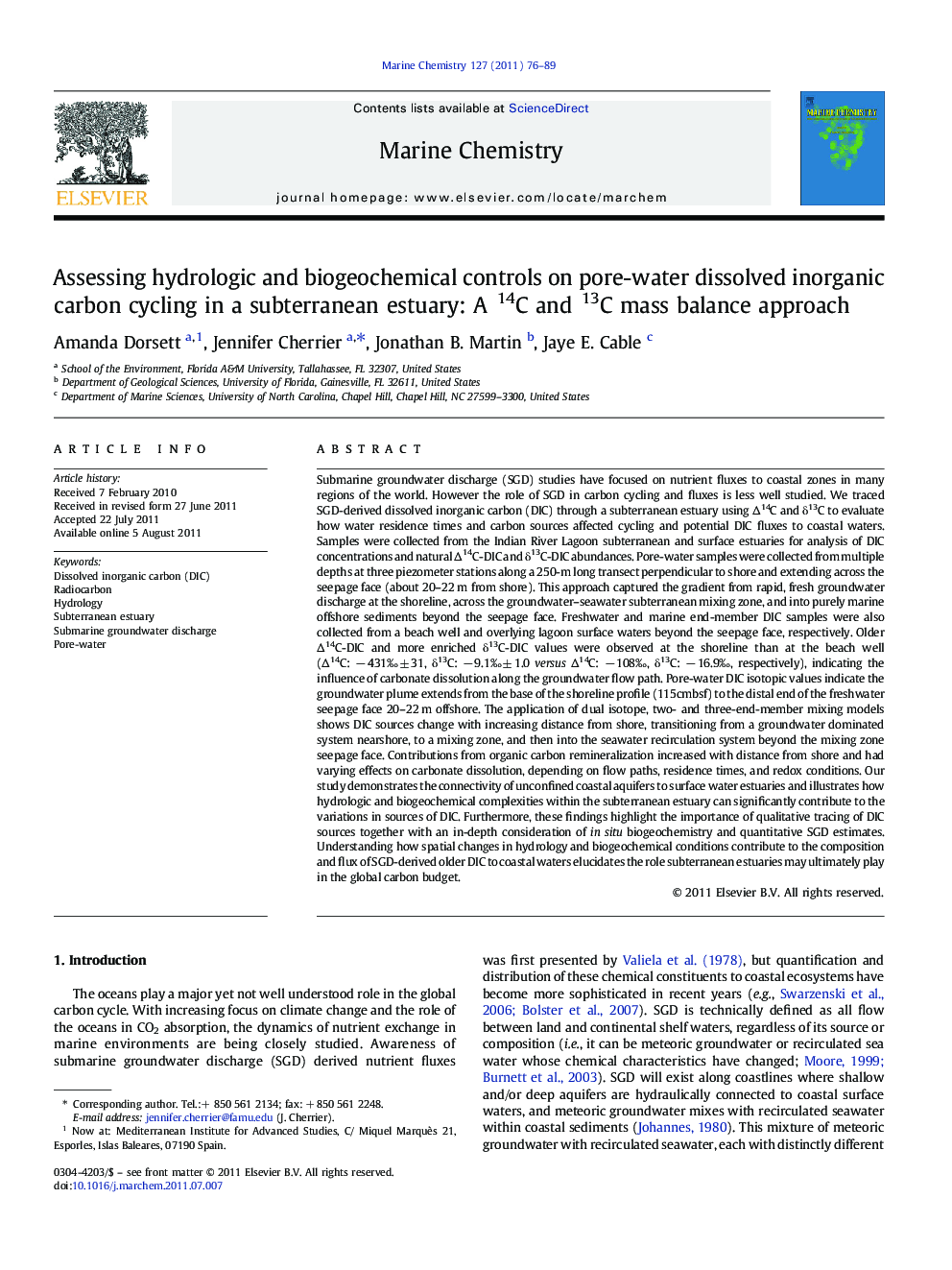| کد مقاله | کد نشریه | سال انتشار | مقاله انگلیسی | نسخه تمام متن |
|---|---|---|---|---|
| 1261483 | 1496697 | 2011 | 14 صفحه PDF | دانلود رایگان |

Submarine groundwater discharge (SGD) studies have focused on nutrient fluxes to coastal zones in many regions of the world. However the role of SGD in carbon cycling and fluxes is less well studied. We traced SGD-derived dissolved inorganic carbon (DIC) through a subterranean estuary using Δ14C and δ13C to evaluate how water residence times and carbon sources affected cycling and potential DIC fluxes to coastal waters. Samples were collected from the Indian River Lagoon subterranean and surface estuaries for analysis of DIC concentrations and natural ∆14C-DIC and δ13C-DIC abundances. Pore-water samples were collected from multiple depths at three piezometer stations along a 250-m long transect perpendicular to shore and extending across the seepage face (about 20–22 m from shore). This approach captured the gradient from rapid, fresh groundwater discharge at the shoreline, across the groundwater–seawater subterranean mixing zone, and into purely marine offshore sediments beyond the seepage face. Freshwater and marine end-member DIC samples were also collected from a beach well and overlying lagoon surface waters beyond the seepage face, respectively. Older ∆14C-DIC and more enriched δ13C-DIC values were observed at the shoreline than at the beach well (∆14C: − 431‰ ± 31, δ13C: − 9.1‰ ± 1.0 versus ∆14C: − 108‰, δ13C: − 16.9‰, respectively), indicating the influence of carbonate dissolution along the groundwater flow path. Pore-water DIC isotopic values indicate the groundwater plume extends from the base of the shoreline profile (115cmbsf) to the distal end of the freshwater seepage face 20–22 m offshore. The application of dual isotope, two- and three-end-member mixing models shows DIC sources change with increasing distance from shore, transitioning from a groundwater dominated system nearshore, to a mixing zone, and then into the seawater recirculation system beyond the mixing zone seepage face. Contributions from organic carbon remineralization increased with distance from shore and had varying effects on carbonate dissolution, depending on flow paths, residence times, and redox conditions. Our study demonstrates the connectivity of unconfined coastal aquifers to surface water estuaries and illustrates how hydrologic and biogeochemical complexities within the subterranean estuary can significantly contribute to the variations in sources of DIC. Furthermore, these findings highlight the importance of qualitative tracing of DIC sources together with an in-depth consideration of in situ biogeochemistry and quantitative SGD estimates. Understanding how spatial changes in hydrology and biogeochemical conditions contribute to the composition and flux of SGD-derived older DIC to coastal waters elucidates the role subterranean estuaries may ultimately play in the global carbon budget.
► Sediment hydrologic and biogeochemical complexities affect DICpw sources and flux.
► Mixing models indicate DICpw sources change with increasing distance from shore.
► Sediment carbon remineralization had varying effects on carbonate dissolution.
► 28% of the water column DIC at study site estimated to come from sediments.
► Estimate 7 to 11% of global coastal water column DIC attributable to sediment flux.
Journal: Marine Chemistry - Volume 127, Issues 1–4, 20 December 2011, Pages 76–89